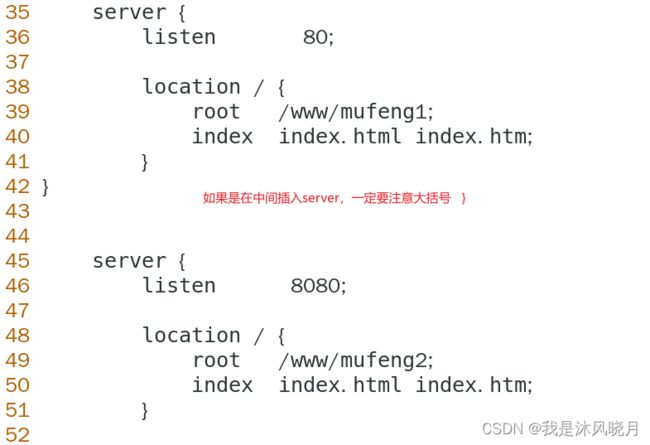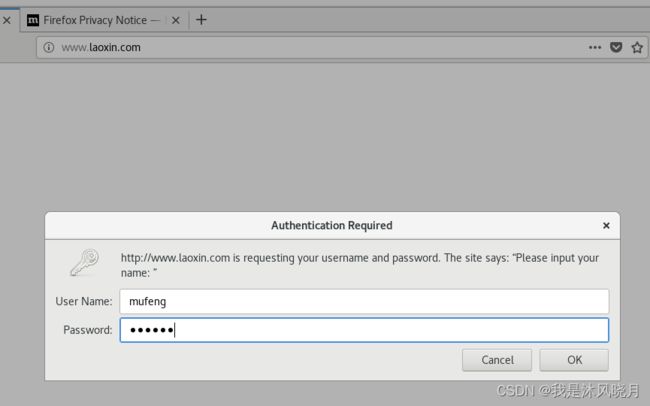【nginx实战】nginx实现虚拟主机及访问认证实战
前言
大家好,我是沐风晓月,本文首发于csdn 博客专栏【linux基本功-系统服务实战】,希望给想要学习架构的小伙伴打造一套系统的专栏,一起学习,共同进步。本文主要讲解nginx实现虚拟主机及访问认证
个人主页:我是沐风晓月
个人简介:大家好,我是沐风晓月,双一流院校计算机专业,阿里云博客专家
座右铭:先努力成长自己,再帮助更多的人,一起加油进步
欢迎大家:这里是CSDN,我总结知识的地方,喜欢的话请三连,有问题请私信
文章目录
- 前言
- 一. nginx配置文件
-
- 1.1 nginx常见的配置文件
- 1.2 nginx主要的配置文件
- 1.3 nginx配置文件示例
- 二. nginx虚拟主机配置
-
- 2.1 基于端口的虚拟主机
- 2.2 基于ip的虚拟主机
- 2.3 基于域名的虚拟机主机
- 三. 访问认证配置
-
- 3.1 基于域名的访问
- 3.2 基于IP的访问控制
- 总结
一. nginx配置文件
1.1 nginx常见的配置文件
主配置文件:/usr/local/nginx/conf/nginx.conf
- 默认启动nginx时,使用的配置文件是:安装路径/conf/nginx.conf文件
- 可以在启动nginx时通过-c选项来指定要读取的配置文件
在conf路径下:
[root@mufeng41 conf]# pwd
/usr/local/nginx/conf
[root@mufeng41 conf]# ls
fastcgi.conf fastcgi_params.default mime.types nginx.conf.default uwsgi_params
fastcgi.conf.default koi-utf mime.types.default scgi_params uwsgi_params.default
fastcgi_params koi-win nginx.conf scgi_params.default win-utf
[root@mufeng41 conf]#
| 配置文件 | 作用 |
|---|---|
| nginx.conf | nginx的基本配置文件 |
| mime.cnf | MIME类型关联的扩展文件 |
| fastcgi.conf | 与fastcgi相关的配置 |
| proxy.conf | 与proxy相关的配置 |
| sites.conf | 配置nginx提供的网站,包括虚拟主机常见的配置文件及其作用 |
1.2 nginx主要的配置文件
主配置文件:/usr/local/nginx/conf/nginx.conf
常用的配置如下:
[root@ mufeng ~]# cat /usr/local/nginx/conf/nginx.conf
(1)user nginx; #配置运行nginx的用户
(2)worker_processes 2; #初始的子进程数量
(3)worker_connections 1024; #配置单个进程处理的最大请求连接数
(4)server{ #配置虚拟主机
(5)listen #配置虚拟主机监听端口
(6)server_name #配置服务器域名
(7)location 匹配规则 { } #配置匹配特定的url
(8)root #配置网站根目录
(9)index #配置虚拟主机的默认首页
(10)error_page 404 /404.html; #解释:当出现404的时候,要重定向到网站根目录下的404.html页面
}
一个Nginx配置文件通常包含3个模块:
- 全局块:比如工作进程数,定义日志路径;
- Events块:设置处理轮询事件模型,每个工作进程最大连接数及http层的keep-alive超时时间;
- http块:路由匹配、静态文件服务器、反向代理、负载均衡等。
1.3 nginx配置文件示例
# 全局块
user mufeng;
worker_processes 2; ## 默认1,一般建议设成CPU核数1-2倍
error_log logs/error.log; ## 错误日志路径
pid logs/nginx.pid; ## 进程id
# Events块
events {
# 使用epoll的I/O 模型处理轮询事件。
# 可以不设置,nginx会根据操作系统选择合适的模型
use epoll;
# 工作进程的最大连接数量, 默认1024个
worker_connections 2048;
# http层面的keep-alive超时时间
keepalive_timeout 60;
# 客户端请求头部的缓冲区大小
client_header_buffer_size 2k;
}
# http块
http {
include mime.types; # 导入文件扩展名与文件类型映射表
default_type application/octet-stream; # 默认文件类型
# 日志格式及access日志路径
log_format main '$remote_addr - $remote_user [$time_local] $status '
'"$request" $body_bytes_sent "$http_referer" '
'"$http_user_agent" "$http_x_forwarded_for"';
access_log logs/access.log main;
# 允许sendfile方式传输文件,默认为off。
sendfile on;
tcp_nopush on; # sendfile开启时才开启。
# http server块
# 简单反向代理
server {
listen 80;
server_name domain2.com www.domain2.com;
access_log logs/domain2.access.log main;
# 转发动态请求到web应用服务器
location / {
proxy_pass http://127.0.0.1:8000;
deny 192.24.40.8; # 拒绝的ip
allow 192.24.40.6; # 允许的ip
}
# 错误页面
error_page 500 502 503 504 /50x.html;
location = /50x.html {
root html;
}
}
# 负载均衡
upstream backend_server {
server 192.168.0.1:8000 weight=5; # weight越高,权重越大
server 192.168.0.2:8000 weight=1;
server 192.168.0.3:8000;
server 192.168.0.4:8001 backup; # 热备
}
server {
listen 80;
server_name big.server.com;
access_log logs/big.server.access.log main;
charset utf-8;
client_max_body_size 10M; # 限制用户上传文件大小,默认1M
location / {
# 使用proxy_pass转发请求到通过upstream定义的一组应用服务器
proxy_pass http://backend_server;
proxy_set_header X-Forwarded-For $proxy_add_x_forwarded_for;
proxy_set_header Host $http_host;
proxy_redirect off;
proxy_set_header X-Real-IP $remote_addr;
}
}
}
二. nginx虚拟主机配置
2.1 基于端口的虚拟主机
[root@mufeng41 conf]# vim nginx.conf
插入代码:
server {
listen 80;
location / {
root /www/mufeng1;
index index.html index.htm;
}
}
server {
listen 8080;
location / {
root /www/mufeng2;
index index.html index.htm;
}
}
[root@mufeng41 nginx-1.22.1]# nginx -t
nginx: the configuration file /usr/local/nginx/conf/nginx.conf syntax is ok
nginx: configuration file /usr/local/nginx/conf/nginx.conf test is successful
[root@mufeng41 nginx-1.22.1]#
- 重启服务
[root@mufeng41 nginx-1.22.1]# nginx -s reload
- 需要创建配置文件中提到的两个目录:
[root@mufeng41 conf]# mkdir -p /www/mufeng1 /www/mufeng2
[root@mufeng41 conf]# touch /www/mufeng1/index.html
[root@mufeng41 conf]# touch /www/mufeng2/index.html
[root@mufeng41 conf]# echo "this is mufeng1" >> /www/mufeng1/index.html
[root@mufeng41 conf]# echo "this is mufeng2" >> /www/mufeng2/index.html
- 测试:
[root@mufeng41 nginx-1.22.1]# curl 192.168.1.41:8080
this is mufeng2
[root@mufeng41 nginx-1.22.1]# curl 192.168.1.41:80
有时候你测试出来,显示的是默认访问html,删掉默认的html里的内容即可:
[root@mufeng41 html]# rm -rf ./*
[root@mufeng41 html]# ls
[root@mufeng41 html]# pwd
/usr/local/nginx/html
[root@mufeng41 html]# curl 192.168.1.41:80
this is mufeng1
2.2 基于ip的虚拟主机
- 修改ip地址
[root@mufeng41 html]# ifconfig |head -3
ens32: flags=4163<UP,BROADCAST,RUNNING,MULTICAST> mtu 1500
inet 192.168.1.41 netmask 255.255.255.0 broadcast 192.168.1.255
inet6 fe80::d524:3f3e:45ed:79c3 prefixlen 64 scopeid 0x20<link>
[root@mufeng41 html]# ifconfig ens32:0 192.168.1.42/24
[root@mufeng41 html]# ifconfig |grep inet
inet 192.168.1.41 netmask 255.255.255.0 broadcast 192.168.1.255
inet6 fe80::d524:3f3e:45ed:79c3 prefixlen 64 scopeid 0x20<link>
inet 192.168.1.42 netmask 255.255.255.0 broadcast 192.168.1.255
inet 127.0.0.1 netmask 255.0.0.0
inet6 ::1 prefixlen 128 scopeid 0x10<host>
inet 192.168.122.1 netmask 255.255.255.0 broadcast 192.168.122.255
[root@mufeng41 html]#
- 修改配置文件
[root@mufeng41 mufeng2]# cat /usr/local/nginx/conf/nginx.conf |tail -22
#}
server {
listen 192.168.1.41:80;
server_name 192.168.1.41;
location / {
root /www/mufeng1;
index index.html index.htm;
}
}
server {
listen 192.168.1.42:80;
server_name 192.168.1.42;
location / {
root /www/mufeng2;
index index.html index.htm;
}
}
}
- 修改hosts
[root@mufeng41 mufeng2]# cat /etc/hosts
127.0.0.1 localhost localhost.localdomain localhost4 localhost4.localdomain4
::1 localhost localhost.localdomain localhost6 localhost6.localdomain6
192.168.1.41 mufeng41
192.168.1.42 mufeng41
- 重启nginx
需要注意的是: 有时候使用重新加载不生效
[root@mufeng41 mufeng2]# nginx -s stop
[root@mufeng41 mufeng2]# nginx
[root@mufeng41 mufeng2]# nginx -t
nginx: the configuration file /usr/local/nginx/conf/nginx.conf syntax is ok
nginx: configuration file /usr/local/nginx/conf/nginx.conf test is successful
- 测试:
[root@mufeng41 mufeng2]# curl 192.168.1.41
this is mufeng1
[root@mufeng41 mufeng2]# curl 192.168.1.42
this is mufeng2
2.3 基于域名的虚拟机主机
- 修改/etc/hosts
[root@mufeng41 mufeng2]# vim /etc/hosts
[root@mufeng41 mufeng2]# cat !$
cat /etc/hosts
127.0.0.1 localhost localhost.localdomain localhost4 localhost4.localdomain4
::1 localhost localhost.localdomain localhost6 localhost6.localdomain6
192.168.1.41 www.laoxin.com
192.168.1.41 www.itlaoxin.com
[root@mufeng41 mufeng2]#
- 修改配置文件
[root@mufeng41 mufeng2]# cat /usr/local/nginx/conf/nginx.conf |tail -22
#}
server {
listen 80;
server_name www.laoxin.com;
location / {
root /www/mufeng1;
index index.html index.htm;
}
}
server {
listen 80;
server_name www.itlaoxin.com;
location / {
root /www/mufeng2;
index index.html index.htm;
}
}
}
[root@mufeng41 mufeng2]#
- 重新加载配置
root@mufeng41 mufeng2]# nginx -t
nginx: the configuration file /usr/local/nginx/conf/nginx.conf syntax is ok
nginx: configuration file /usr/local/nginx/conf/nginx.conf test is successful
[root@mufeng41 mufeng2]# nginx -s reload
[root@mufeng41 mufeng2]#
- 测试
[root@mufeng41 mufeng2]# nginx -s stop
[root@mufeng41 mufeng2]# nginx
[root@mufeng41 mufeng2]# curl www.itlaoxin.com
this is mufeng2
[root@mufeng41 mufeng2]# curl www.laoxin.com
this is mufeng1
[root@mufeng41 mufeng2
三. 访问认证配置
3.1 基于域名的访问
- 修改配置文件
[root@mufeng41 mufeng2]# cat /usr/local/nginx/conf/nginx.conf |tail -15
server {
listen 80;
server_name www.laoxin.com;
location / {
root /www/mufeng1;
index index.html index.htm;
auth_basic "Please input your name: ";
auth_basic_user_file /usr/local/nginx/conf/nginxpasswd;
}
}
}
- 添加用户和密码
[root@mufeng41 mufeng2]# useradd mufeng
[root@mufeng41 mufeng2]# yum install http* -y &>/dev/null && echo "ok"
ok
[root@mufeng41 mufeng2]# htpasswd -c /usr/local/nginx/conf/nginxpasswd mufeng
New password:
Re-type new password:
Adding password for user mufeng
[root@mufeng41 mufeng2]#
- 重启服务
[root@mufeng41 mufeng2]# nginx -s stop
[root@mufeng41 mufeng2]# nginx
3.2 基于IP的访问控制
server {
listen 80;
server_name www.laoxin.com;
location / {
root /www/mufeng1;
index index.html index.htm;
allow 192.168.1.; #allow允许某个ip地址或者网段访问
deny all; 拒绝某个ip或者网段访问
}
}
#备注:优先级自上而下,优先匹配上面的规则,其次是下面的规则
总结
好啦,这就是今天要分享给大家的全部内容了,我们下期再见!
博客主页:mufeng.blog.csdn.net
本文由沐风晓月原创,首发于CSDN博客
全力以赴,持续学习,不负如来不负卿,喜欢的话记得点赞收藏哦



